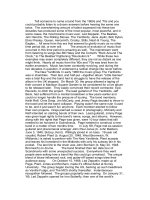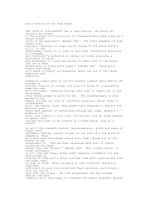History of agricultural development
Bạn đang xem bản rút gọn của tài liệu. Xem và tải ngay bản đầy đủ của tài liệu tại đây (1.57 MB, 43 trang )
History of Agricultural
Development
History and Types of
Agriculture
Demand-based agriculture - production
determined by economic demand and limited by
classical economic supply and demand theory.
This approach became common during the
industrial revolution.
Resource-based agriculture - production
determined by resource availability; economic
demand usually exceeds production. This
approach was the original type of farming 10,000
years ago. Modern approaches are very high
tech and somewhat more expensive.
History of Agriculture
Agroecosystems
• Ecosystem created by agricultural
practices
– characterized by low
• Genetic diversity
• Species diversity
• Habitat diversity
Agroecosystems
Agroecosystems differ from natural ecosystems in five major
ways:
1. Farming attempts to stop ecological succession
2. Species diversity is low
a.farmers usually practice monoculture
b.monoculture tends to ⇓ soil fertility
3. Farmers plant species (crops) in an orderly fashion - this can
make pest control more difficult
4. Food chains are far more simple in agroecosystems
5. Plowing is like no other natural disturbance
a.plowing can ⇑ erosion
b.cause more nutrient loss (which is replaced by fertilizer)
World Food Supply and the
Environment
• Our current food problem is the result of our
human population
• Food production depends upon favorable
environmental conditions
• Agriculture changes the environment - such
changes can be detrimental
• Food supply can be adversely affected by
social unrest that influence agriculture
So what is agriculture?
– The deliberate modification of Earth’s surface
through cultivation of plants and rearing of
animals to obtain sustenance or economic
gain.
– Intentional planting of crops and raising of
domesticated animals
ORIGINS OF AGRICULTURE
• Hunters and Gatherers
• Invention of Agriculture
HUNTERS AND GATHERERS
• Before the invention of agriculture, all humans
probably obtained the food they needed for
survival through hunting for animals, fishing, or
gathering.
• Hunters and gatherers lived in small groups.
• The men hunted game or fished, and the women
collected berries, nuts, and roots.
Hunter & Gatherers
• 99% of mankind’s existence on Earth has
been as a HUNTER & GATHERER!
• Hunting/gathering behaviors exist back 2
million years to the dawn of man’s cultural
evolution.
• Earth’s carrying capacity for huntergatherers estimated at 20-30 million.
• Do hunting/gathering societies still exist
today?
HUNTERS AND GATHERERS
• This division of labor sounds like a stereotype
but is based on evidence from archaeology and
anthropology.
• The group traveled frequently, establishing new
home bases or camps.
• The direction and frequency of migration
depended on the movement of game and the
seasonal growth of plants at various locations.
Hunter-Gatherers
• Hunter-gatherers are people who obtain
food by collecting plants and by hunting
wild animals or scavenging their remains.
• Hunter-gatherers affect their environment
in many ways:
1) Native American tribes hunted buffalo.
2) The tribes also set fires to burn prairies and
prevent the grow of trees. This left the prairie
as an open grassland ideal for hunting bison.
Hunter-Gatherers
• In North America, a combination of rapid
climate changes and overhunting by
hunter-gatherers may have led to the
disappearance of some large mammal
species, including:
1)
2)
3)
4)
5)
giant sloths
giant bison
mastodons
cave bears
saber-toothed cats
CONTEMPORARY HUNTING AND GATHERING
• Today perhaps a quartermillion people, or less than
0.005 percent of the world’s
population, still survive by
hunting and gathering.
• Contemporary hunting and
gathering societies are
isolated groups living on the
periphery of world
settlement, but they provide
insight into human customs
that prevailed in prehistoric
times, before the invention
of agriculture.
Transition from
Hunting-Gathering to Agriculture
•
Human population growth rate increased slowly:
A. .0007-.0020 % /yr.
Pleistocene age
B. .1 % /yr.
Neolithic
C. 1-2 % /yr.
Present day
•
Low birth rate attributed to lifestyle of hunter-gatherer –
not food scarcity. Were children an asset??
•
Not ignorance of plant growth, but lack of need to
practice agriculture prevented earlier development of
agriculture.
Transition from Hunting-Gathering to Agriculture
continued…
Man simultaneously developed agriculture
worldwide 10,000 years ago, after the last
Ice Age…suggests that climate changes
contributed to the cultivation of plants.
THE INVENTION OF AGRICULTURE
• Agriculture evolved into two types of
cultivation.
– Vegetative Planting
– Seed Agriculture
TWO TYPES OF CULTIVATION
• Over thousands of years, plant cultivation
apparently evolved from a combination of
accidental and deliberate experiment.
• The earliest form of plant cultivation, according
to Carl Sauer, was vegetative planting, direct
cloning from existing plants, such as cutting
stems and dividing roots.
• Coming later, according to Sauer, was seed
agriculture. Seed agriculture is practiced by
most farmers today.
VEGETATIVE PLANTING HEARTHS
• There were several main hearths, or centers of origin, for
vegetative crops (roots and tubers, etc.), from which the
crops diffused to other areas.
LOCATION OF FIRST
VEGETATIVE PLANTING
• Dr. Sauer believes that vegetative planting probably
originated in Southeast Asia.
• The region’s diversity of climate and topography
encouraged plants suitable for dividing.
• The first plants domesticated in Southeast Asia.. .
probably included roots such as the taro and yam, and
tree crops such as the banana and palm.
• The dog, pig, and chicken probably were domesticated
first in Southeast Asia.
• Other early hearths of vegetative planting also may have
emerged independently in West Africa and northwestern
South America.
SEED AGRICULTURAL HEARTHS
• Seed agriculture also originated in several hearths and
diffused from those elsewhere.
Major Agricultural Hearths
Mesopotamia
(6,500 B.C.)
Huang He
(4,500 B.C.)
Indus
(4,700 B.C.)
Nile
(5,000 B.C.)
Ganges
(4,700 B.C.)
Irrigated agriculture
Collective effort
Governments
2
2
DIFFUSION OF SEED
AGRICULTURE
• Seed agriculture diffused from Southwest Asia
across Europe and through North Africa.
• Seed agriculture also diffused eastward from
Southwest Asia to northwestern India and the
Indus River plain.
• Again, various domesticated plants and animals
were brought from Southwest Asia, although
other plants, such as cotton and rice, arrived in
India from different hearths.
• Rice has an unknown hearth.
• Sauer identified a third independent hearth in
Ethiopia, where millet and sorghum were
domesticated early.
• However, he argued that agricultural advances in
Ethiopia did not diffuse widely to other locations
Ancestral Wheat and Barley
DIFFUSION OF SEED
AGRICULTURE IN THE
WESTERN HEMISPHERE
• Two independent seed agriculture hearths
originated in the Western Hemisphere: southern
Mexico and northern Peru.
• Agricultural practices diffused to other parts of the
Western Hemisphere.
• This diversity derives from a unique legacy of wild
plants, climatic conditions, and cultural preferences
in each region.
• Improved communications in recent centuries have
encouraged the diffusion of some plants to varied
locations around the world.









